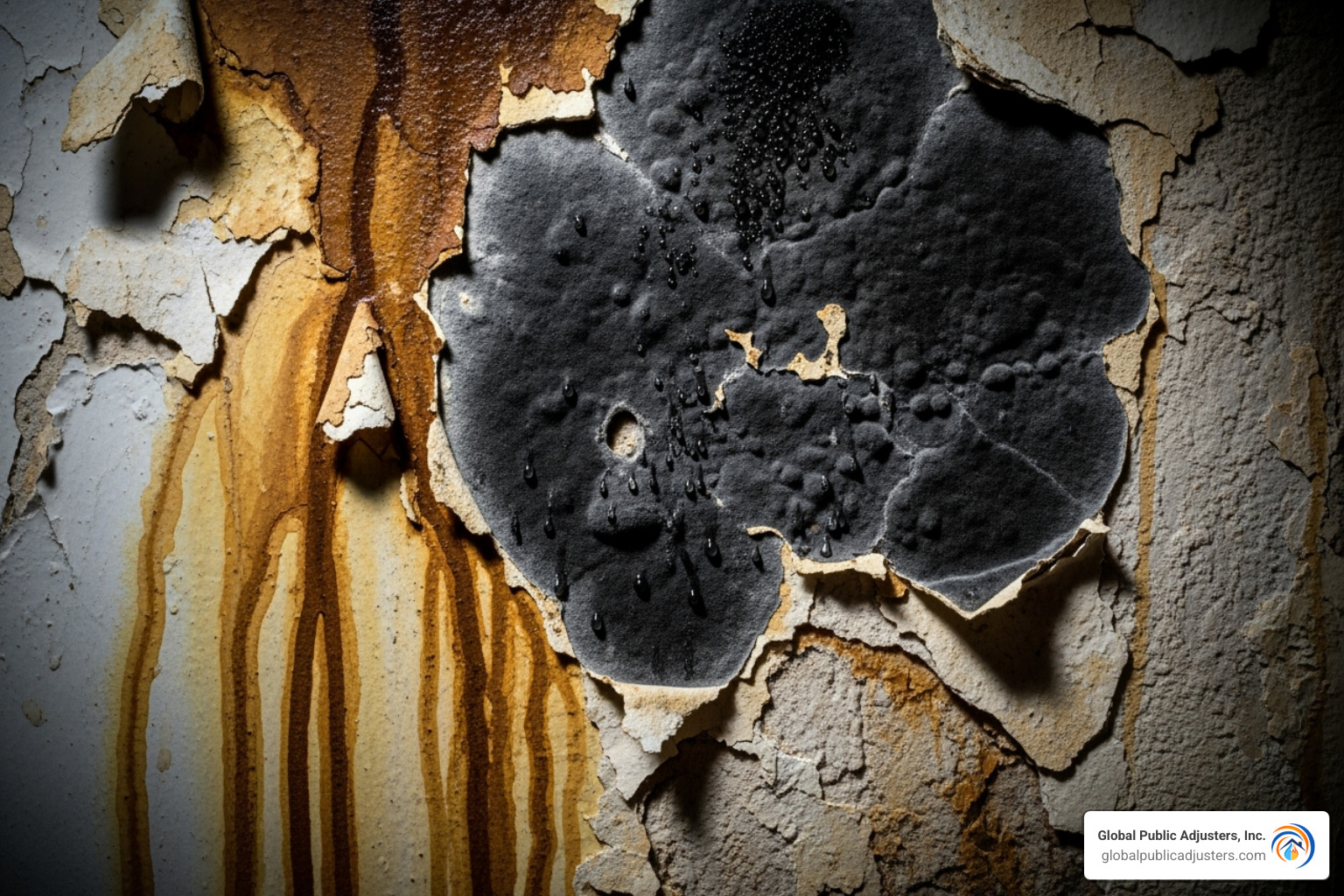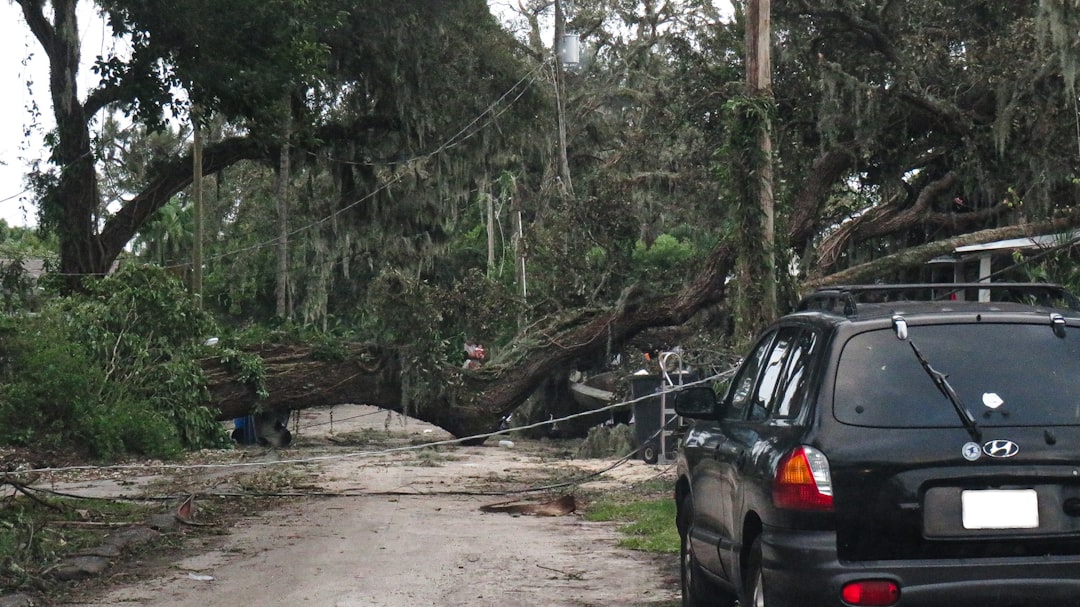Denied Mold Damage Claim: 4 Steps to Win
Why Your Mold Damage Claim Was Denied and What You Can Do
Adenied mold damage claimis devastating, especially when you’re already facing property damage and potential health risks. The good news is that most denials can be successfully challenged with the right approach.
Quick Answer for Denied Mold Claims:
- Review your denial letterto understand the specific reason cited.
- Gather strong evidencelike photos, professional reports, and repair estimates.
- Appeal the decisionby presenting new documentation that addresses their concerns.
- Consider professional helpfrom a public adjuster to maximize your settlement.
Insurers deny mold claims for predictable reasons, such as claiming the damage was “gradual,” pointing to policy exclusions, or arguing you failed to maintain your property. Understanding these tactics is the first step to overturning a denial.
“Insurance companies have traditionally sought to minimize the amount they pay for any mold or black mold claims,”according to industry experts. With rising remediation costs, homeowners face an uphill battle.
The reality is stark:Standard homeowners policies often cap mold coverage at just $1,000-$10,000. When remediation costs exceed this, or your claim is denied entirely, you must act strategically.
A denial letter isn’t the final word. Successful appeals require thorough documentation, policy knowledge, and persistence.

Denied mold damage claimword list:
- can you file a homeowner claim for mold damage
- insurance claims for mold damage
- florida attorneys mold and water damage claims
Why Insurance Companies Deny Mold Damage Claims
Finding mold is overwhelming, and adenied mold damage claimmakes it worse. Understanding why insurers deny mold claims is the first step to fighting back.
Insurers are for-profit businesses. With remediation costing tens of thousands, they use sophisticated strategies to minimize or deny mold claims.

Your policy’s complex language favors the insurer. It’s filled with exclusions for mold, wear and tear, and faulty workmanship, which adjusters are trained to use against you.
This combination of policy language, profit motives, and claim complexity leads to denials. But understanding these tactics empowers you to fight back.
The Crucial Difference: Sudden vs. Gradual Damage
The distinction between “sudden and accidental” versus “gradual” damage is critical and often decides the fate of adenied mold damage claim.
Insurers typically cover mold from asudden, covered peril, like a burst pipe or overflowing appliance. The resulting mold from this unexpected water intrusion may be covered.
Crucially,mold itself isn’t the covered peril; it’s the consequence of covered water damage. You must prove a sudden, accidental event caused the moisture.
However, mold fromgradual sourceslike slow leaks or long-term seepage faces automatic denial. Insurers classify these as “maintenance issues,” not covered perils.
Insurers argue thatgradual damageis preventable negligence that should have been addressed through regular home maintenance. The challenge is proving your case, as insurers may claim you should have found a leak sooner through proper inspection.
Policy Exclusions and Coverage Limits
Even with a sudden event, yourstandard homeowners policyhas exclusions and limits that can sink your claim. Most policies require a separate endorsement for meaningful mold coverage.
Theflood damage exclusionis a major barrier. Standard policies never cover flooding or resulting mold. For example, mold from Hurricane Ian’s storm surge requires separate flood insurance, which also has strict limits.
Other common exclusions arewear and tear,faulty workmanship, and even “pollution,” which some policies use to classify mold.
But the biggest issue iscoverage caps. Most policies limit mold payouts to just$1,000 to $10,000per occurrence. With remediation often costing $15,000 to $30,000 or more, these limits are inadequate.
For instance, after Hurricane Ian, one client’s $30,000 remediation bill was only covered up to their $10,000 policy limit, leaving them with a $20,000 shortfall.
The good news is you can buymold insurance endorsementsto increase coverage. These riders are vital for older homes or properties in humid climates like Florida.
More info about mold insurance endorsements
More info about reasons why your property insurance claim can be denied
The Role of Homeowner Negligence and Maintenance
Insurers often blame homeowners forfailure to maintaintheir property. This is a go-to defense strategy behind manydenied mold damage claims.
Policies cover unforeseen events, not maintenance issues. Insurers scrutinize your property care for any sign of negligence.
- Unrepaired leaksare a top reason for denial. Insurers will argue that even a small, unfixed drip is your responsibility, not theirs.
- Poor ventilationin bathrooms, kitchens, or basements is another target. Insurers will claim it’s a maintenance failure that you could have prevented.
- Clogged gutterscan cause water intrusion, and insurers will blame resulting mold on poor maintenance.
The timeline is also critical. Mold grows in24 to 48 hours, so any delay in addressing moisture can be seen as negligence.
Property owner responsibilityis broad. Insurers expect regular inspections, prompt moisture mitigation, and proper humidity control.
What constitutes neglect in a mold claim
Insufficient or Improper Documentation
Theburden of proofis on you. Without comprehensive documentation, even a valid claim can result in adenied mold damage claim.
- Lack of photosis a common failure. You need clear, dated photos of the water source, damage, and moldbeforecleanup begins, as this is crucial evidence.
- Missing repair receiptscan also doom a claim. Keep records of all mitigation efforts to prove you acted responsibly.
- Vague reportsare ineffective. Replace general statements with specific details. Professional inspection reports are far more credible than personal observations.
- Failure to report promptlyis another reason for denial. Policies require “prompt notification,” and long delays can jeopardize your claim.
Start documenting the moment you find damage. Every photo and receipt strengthens your case.

Your Proactive Guide to Preventing Mold and Future Denials
No one wants mold or adenied mold damage claim. The good news is you have more control over preventing both than you might think.
Proactive moisture control and understanding your insurance policy are the keys to prevention. It’s an investment in your home’s health and your peace of mind.

Most mold problems start small. Insurers know this and often blame poor maintenance. Staying ahead of issues protects your property and strengthens any future claim.
Essential Home Maintenance to Control Moisture
Mold needs moisture to grow. Eliminating moisture is the key. This is about developing smart maintenance habits to protect your home.
- Fixing leaks promptlyis your top priority. Even a small drip can lead to mold and give your insurer grounds to deny a claim for “gradual damage.”
- Controlling humidity levelshelps prevent mold. Keep indoor humidity between 30-50%. In humid climates like Florida, dehumidifiers are essential for basements and crawl spaces.
- Proper ventilationis often overlooked. Use exhaust fans in kitchens and bathrooms during moisture-producing activities. Ensure your dryer vents outside.
- Gutter maintenanceis crucial. Clogged gutters can cause water to seep into your foundation or roof, leading to hidden mold growth.
- Remove wet materials immediatelyafter water intrusion. Mold can grow on damp carpets and furniture within 24 to 48 hours.
How to control mold in your home
How to Spot the Early Signs of Mold
Mold can be obvious or hidden behind walls. Recognizing early signs can save you thousands and help prevent adenied mold damage claim.
- Visible growthisn’t always obvious. Look for fuzzy patches or discoloration in various colors (black, green, white, orange), not just dirt.
- Musty or damp odorsare a key sign of mold. If you smell a persistent earthy odor, investigate. Your nose can often detect mold before you see it.
- Water stains or peeling paintsignal moisture problems that feed hidden mold. These cues indicate leaks that need immediate attention.
- Health symptomslike unexplained coughing, wheezing, or skin irritation can indicate a mold problem, especially if they occur in specific areas of your home.
Act quickly on any of these signs. Early intervention protects your health and your potential insurance claim.
More info about how to tell if you have mold damage in your home
Understanding Your Homeowners Insurance PolicyBeforeYou Need It
Most homeowners don’t read their policy until they file a claim. By then, it may be too late to avoid adenied mold damage claim.
- Read your policy documents.It’s one of the most valuable things you can do. Review the declarations page, covered perils, and exclusions, focusing on water damage and mold.
- Understand your coverage limits.Standard policies often cap mold coverage at $1,000-$10,000, which is often insufficient for remediation costs of $15,000 or more.
- Policy exclusionsare the insurer’s escape route. Look for exclusions for gradual damage, wear and tear, and maintenance issues, which are common reasons for denial.
- Mold riders and endorsementsexpand your protection. Consider this extra coverage if you live in a humid climate or have an older home.
- Review your policy annually.Insurers can change terms, exclusions, or limits. Don’t assume your coverage is the same year after year.
Understanding your policy beforehand puts you in a stronger position to document a claim and challenge a denial.
More info about navigating mold damage claims
What to Do When You Have a Denied Mold Damage Claim
Adenied mold damage claimletter is stressful, but it’s not the end. A denial is often just the insurer’s first move, and you can still win the claim.
Insurers expect appeals, as many homeowners simply give up. Don’t be one of them. With the right approach and solid evidence, many denied claims can be successfully overturned.
The key is to be methodical and strategic. Every piece of evidence matters, so document every step.
Step 1: Review the Denial Letter and Your Policy
Your denial letter is a roadmap to the insurer’s reasoning. Study it carefully.
Identify the specific reason for denial.Whether it’s gradual damage, a policy exclusion, or alleged poor maintenance, their reasoning is your target.
Next, get your complete policy documents.Compare the denial letter to your actual policy.Insurers sometimes misinterpret their own policies or cite inapplicable clauses.
Look for contradictions. If they cite gradual damage but you can prove a sudden event, that’s the foundation of your appeal.
More info about what to do when your home insurance claim is denied
Step 2: Gather Comprehensive Evidence and Documentation
This step is critical. The insurer decided based on limited information. Your job is to provide compelling evidence that makes their denial indefensible.
- Gather visual evidence.Use new and old photos/videos. Date-stamped photos are best for establishing a timeline.
- Keep a detailed communication logwith dates, times, names, and discussion summaries. This proves you’ve been cooperative.
- Get multiple estimates from qualified professionals.Detailed assessments from licensed mold remediation specialists carry more weight than an adjuster’s opinion.
- Hire a certified mold inspectorfor an independent assessment. Their report identifying the mold type, cause, and extent of contamination is powerful evidence.
- Keep all receiptsfor repairs and supplies. They prove you acted responsibly to mitigate damage.
- Document your maintenance historywith receipts for repairs to counter claims of negligence.
Step 3: How to Appeal a Denied Mold Damage Claim
Your appeal letter is your chance to present a clear, professional, and compelling case that directly addresses the insurer’s reasons for denial.
- Start with the basics:policy number, claim number, and a formal statement of appeal referencing the denial letter’s date.
- Address their reasoning head-on.Counter claims of gradual damage with evidence of a sudden event. Refute negligence claims with maintenance records. Explain why cited exclusions don’t apply.
- Use your policy language.Quote sections that support your claim. Ambiguous language in a policy is typically interpreted in the policyholder’s favor.
- Present evidence systematically.Organize your documents and reference them clearly in your letter to make your argument easy to follow.
- Be persistent but professional.A respectful, business-like tone is more effective than an emotional one.
- Send your appeal via certified mailwith return receipt requested to create a paper trail.
Step 4: When to Hire Professional Help for a Denied Mold Damage Claim
If the insurer continues to deny, offers a lowball settlement, or drags out the process, professional help becomes essential.
- Complex claims require expert navigation.A professional can clarify complicated factors and timelines to present a compelling case.
- Lowball settlement offers are common.Professional advocates know how to negotiate these offers up to a fair amount.
- Bad faith tacticslike unreasonable delays or improper investigations require a professional response. Experts can recognize these tactics and know how to counter them.
This is why public adjusters like Global Public Adjusters, Inc. exist. We work only for you, not the insurer. With over 50 years of experience, we know every trick insurers use to deny claims.
We handle the entire process, from damage assessment to negotiating a maximum settlement. We know how to present evidence in ways insurers can’t ignore. Our expertise uncovers damage and coverage homeowners miss.
When yourdenied mold damage claimis overwhelming, you don’t have to fight alone. We serve homeowners throughout Florida, including Orlando, and are ready to put our experience to work for you.
More info about why to hire a public adjuster for mold damage
Frequently Asked Questions about Denied Mold Claims
We’ve helped homeowners withdenied mold damage claimsfor decades, and certain questions come up repeatedly. Here are answers to the most common concerns.
Can I reopen a denied mold claim if I have new evidence?
Yes. A denial isn’t final. If yourdenied mold damage claimwas based on incomplete information, you can present new evidence that addresses the insurer’s specific concerns.
The new evidence must directly challenge the reason for denial. Anindependent expert’s reportproving sudden damage or documents showing proper maintenance can be compelling enough to reopen a claim, even months later. Present new information clearly, explaining how it refutes their reasoning. Insurers must reconsider claims when substantial new evidence is provided.
What is the difference between the insurance company’s adjuster and a public adjuster?
This is a critical distinction, especially with adenied mold damage claim.
The insurance company’s adjuster works for the insurer, not you. Their job is to protect the company’s bottom line by minimizing or denying claims.
A public adjuster works exclusively for you, the policyholder. We are your advocate, focused on maximizing your settlement. We use our knowledge of insurance tactics to fight for your interests.
Think of it like court: you wouldn’t share a lawyer with the other side. A public adjuster levels the playing field and improves your chances of overturning a denial.
Is it worth filing a claim if the mold damage is minor?
This is a smart question. The answer depends on yourdeductibleand theestimated remediation costs.
If cleanup costs are only slightly more than your deductible, filing might not be worth it. A small claim could lead to higher premiums for years. For example, with a $2,000 deductible on a $2,400 repair, you’d only get $400 but could face increased rates.
However, don’t guess.Get professional estimates first.What appears minor could be a sign of extensive hidden damage. We’ve seen small issues turn into major remediation projects.
The smart approach is to get quotes, compare them to your deductible, and consider your claims history before filing.
Conclusion: Taking Control of Your Mold Damage Claim
Adenied mold damage claimisn’t the final word. We know it’s overwhelming, but most denials can be successfully challenged with the right approach.
This guide explained the common reasons for denial, from “gradual damage” to policy exclusions.Understanding the insurer’s playbook gives you power.
Taking control requiresproactive prevention, thorough documentation, and persistent advocacy.Preventing mold demonstrates responsible homeownership, and when problems arise, meticulous documentation is your strongest weapon.
Documentation is crucial.Photos, receipts, and professional reports are the evidence that can turn a denial into an approval.
When facing a denial, don’t get paralyzed. Review the denial letter and your policy, gather evidence to counter their reasoning, and present your appeal professionally. When the process is too complex, with lowball offers or bad faith tactics, professional help is essential.
At Global Public Adjusters, Inc., we have over 50 years of experience fighting for homeowners. We understand the frustration of dealing with insurers.We work exclusively for you, not the insurance company.
Our role is to accurately assess your damage, steer complex policy language, and advocate for your rights. We handle negotiations so you can focus on recovery. We serve homeowners in Orlando, Pensacola, and throughout Florida.
Don’t let adenied mold damage claimdiscourage you. With the right knowledge and advocacy, you can challenge the denial and get the settlement you deserve. Contact us today for a free inspection—your claim deserves a champion.




